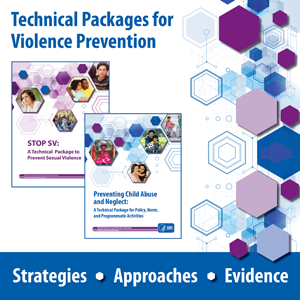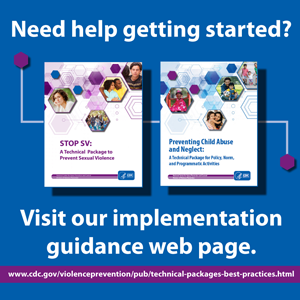Technical Packages for Violence Prevention: Using Evidence-based Strategies in Your Violence Prevention Efforts

The Centers for Disease Control and Prevention (CDC) has developed technical packages to help states and communities take advantage of the best available evidence to prevent violence.
- Preventing Intimate Partner Violence Across the Lifespan: A Technical Package of Programs, Policies, and Practices [PDF 4.52MB]
- Preventing Suicide: A Technical Package of Policy, Programs, and Practices [PDF 4.92MB]
- A Comprehensive Technical Package for the Prevention of Youth Violence and Associated Risk Behaviors [PDF 4.09MB]
- STOP SV: A Technical Package to Prevent Sexual Violence [PDF 3MB]
- Preventing Child Abuse & Neglect: A Technical Package for Policy, Norm, and Programmatic Activities [PDF 3.69MB]
To better understand how you can use these technical packages, here are answers to some frequently asked questions:
What is a technical package?
A technical package is a collection of strategies that represent the best available evidence to prevent or reduce public health problems like violence. They can help improve the health and well-being of communities.
A technical package has three parts.
- The strategy lays out the direction or actions to achieve the goal of preventing violence.
- The approach includes the specific ways to advance the strategy. This can be accomplished through programs, policies, and practices.
- The evidence for each of the approaches in preventing violence or its associated risk factors is included as the third component.
Why were these technical packages developed?
CDC’s former Director, Dr. Tom Frieden named technical packages as one of the six key components for effective public health program implementation. He wrote in the American Journal of Public Health that:
The most effective public health programs are based on an evidence-based technical package…A technical package of proven interventions sharpens and focuses what otherwise might be vague commitments to “action” by committing to implementation of specific interventions known to be effective. It also avoids a scattershot approach of using a large number of interventions, many of which have only a small impact.
Each package is intended as a resource to guide and inform prevention decision-making in communities and states. CDC plans to develop technical packages to highlight the best available evidence in preventing sexual violence, child abuse and neglect, youth violence, intimate partner violence, and suicide.
How were the technical packages developed?
A group of CDC expert scientists reviewed the prevention literature and considered the best possible evidence available around a select group of strategies to prevent violence from happening in the first place or to lessen harms and prevent future risk. The group identified approaches that states and communities could implement to advance the strategies and also described how various sectors could support implementation. Packages were then reviewed by grantees/funded partners, federal partners, and other audiences.
How should these technical packages be used?

The strategies and approaches in the technical package represent different levels of the social ecology with efforts intended to impact individual behaviors as well as the relationship, family, school, community, and societal factors that influence risk and protective factors for violence. They are intended to work together and to be used in combination in a multi-level, multi-sector effort to prevent violence.
Sectors vital to the implementation of these packages include:
- Education
- Government (federal, state, and local)
- Social services
- Healthcare services
- Businesses
- Justice
- Housing
- Faith-based and other organizations
- Foundations
The hope is that multiple sectors will use these packages to take advantage of the best available evidence and join CDC in efforts to prevent violence.
Read more on how you can get started implementing the technical package in your violence prevention work.
- Page last reviewed: June 13, 2017
- Page last updated: June 13, 2017
- Content source:


 ShareCompartir
ShareCompartir
